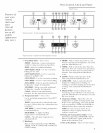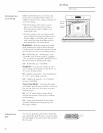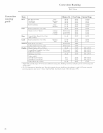
Using the Probe tbr Roasting
7Ernperature
probe
For many foods, especially roasts and poultry,
internal _bod temperature is the best test _i)r
doneness. The temperature probe takes the
guesswork out of roasting by cooking lbods to
the exact d(meness you want.
Use of probes other than the one provided with
this product may result in damage to the probe,
Use the handles of tile probe and plug when
inserting and removing them fl'om the meat
and oven outlet.
* To avoid damaging the probe, do not use
tongs to pull on the cable when removing it.
* To avoid breaking the probe, make sure tood
is completely defl'osted before inserting.
* To prevent possible burns, do not unplug
tile probe fl'om the outlet tmtil the oven
has cooled.
* Nexer leave the probe inside the oxen
dm'ing a broil or sell'cleaning c}cle.
* Do not store the probe in the oxen.
Plug
Handles
Probe
Tbetemperatureprobehasa skewer-likeprobeat oneendanda plug
attbe otherendtbat goesintotbe outlet in theoven.
D_Dper
placement
of the probe
_Mter preparing the meat and placing it on
the broiler pan grid, follow these directions for
proper probe placement.
* The tip of the probe shonld rest in the center
of the thickest meaty part of the roast,
* The probe must be inserted completely into
the meat, up to the handle, in order ti)r it to
read the temperature properly. It should not
touch the bone, tht or gristle,
For roasts with no bone, insert the probe into
the meatiest part of the roast, For bone-in ham
or lamb, insert the probe into the center of the
lowest large muscle or joint.
Insert the probe into the center of dishes such
as meat loa_ or casseroles. When cooking fish,
insert the probe fl'om just above the gill into
the meatiest area, parallel to the backbone.
Insert the probe into the meatiest part of the
inner thigh from below and parallel to the leg
of a whole turke>
18


















